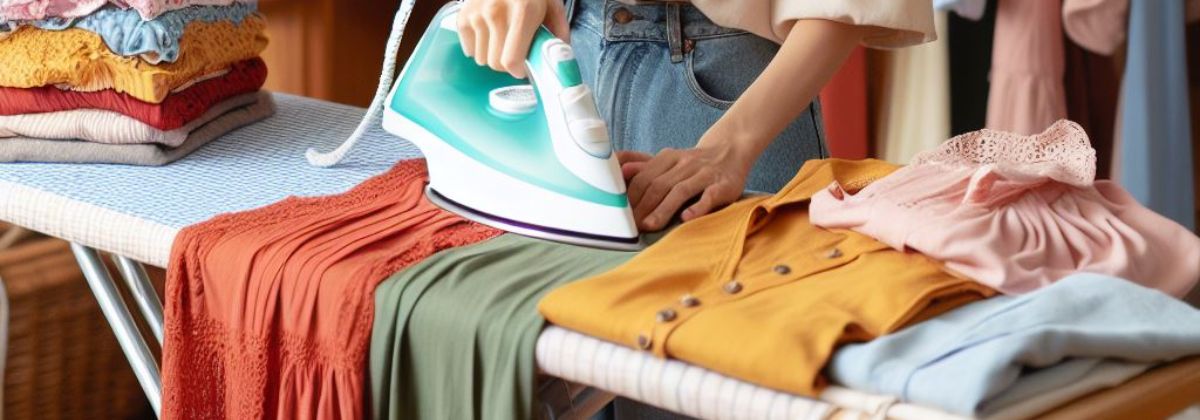23 Feb Ironing Skirts: Tips and Techniques for Perfectly Wrinkle-Free Results
Ironing might seem mundane, but mastering the art ensures your garments look impeccably polished and well cared for every time you wear them. This guide delves into essential tips and techniques tailored for ironing skirts, helping you navigate the fabric varieties and ensuring your favourite skirts are always ready to make a stylish statement.
So, let’s dive into the world of crease-free elegance and discover how to elevate your ironing game. Whether you’re a seasoned pro or a newcomer to the ironing board, these tips will help you effortlessly achieve that crisp, professional look. Get ready to transform your ironing routine and make your skirts the envy of the wardrobe!
Choosing the Right Iron and Board for Ironing Skirts
Selecting the appropriate iron and ironing board is crucial in achieving flawless results when ironing your skirts. The right equipment makes the process more efficient and contributes to the longevity of your garments. Let’s explore the critical considerations for choosing the perfect iron and ironing board.
Importance of the Right Equipment
Investing in a high-quality iron is the foundation of successful ironing. Look for an iron with adjustable temperature settings to cater to various fabrics. A smooth and well-maintained soleplate ensures even heat distribution, preventing accidental burns or uneven creases.
Similarly, choosing the right ironing board is essential. Consider the height of the board, as it should match your own to prevent unnecessary strain on your back and shoulders. A stable and well-constructed ironing board provides a secure surface for efficient ironing.
Features to Look for in an Iron
- Adjustable Temperature Settings: Different fabrics require different heat levels. Ensure your iron allows you to customise the temperature according to the garment’s care label.
- Steam Functionality: Steam can be a game-changer for tackling stubborn wrinkles. Opt for an iron with a reliable and adjustable steam feature.
- Cord Length and Flexibility: A longer cord and a flexible design make it easier to manoeuvre the iron across the ironing board, reaching every part of your skirt effortlessly.
- Anti-Drip Feature: Prevent water droplets from staining your garments by choosing an iron with an anti-drip feature, mainly if you frequently use the steam function.
Selecting the Perfect Ironing Board
- Height Adjustment: An adjustable ironing board accommodates users of different heights, ensuring a comfortable and ergonomic ironing experience.
- Stability: Look for a sturdy and stable ironing board to prevent wobbling or collapsing during use. A stable board contributes to smoother ironing.
- Cover Quality: A smooth and padded ironing board cover enhances the overall ironing experience. Opt for a cover with heat-reflective properties for more efficient results.
- Storage Convenience: Consider the storage space available in your home. Some ironing boards come with space-saving features, making them ideal for smaller living spaces.
Preparing Your Skirt for Ironing
Before ironing your skirt, investing a little time in preparing the garment is crucial. These pre-ironing steps not only contribute to a smoother ironing process but also help preserve the quality of your skirt. Let’s delve into the essentials of preparing your skirt for the iron.
Checking Fabric Labels
- Know Your Fabric: Different fabrics have distinct ironing requirements. Refer to the care label on your skirt to understand the fabric type and any specific instructions provided.
- Temperature Guidelines: The care label often indicates the recommended ironing temperature. Ensure your iron is set to the appropriate heat level to avoid damaging the fabric.
Emptying Pockets and Turning Skirt Inside Out
- Avoid Unpleasant Surprises: Emptying pockets before ironing prevents mishaps, such as accidentally ironing over forgotten items. This simple step ensures a smooth ironing experience.
- Protecting the Outer Layer: Turning the skirt inside out before ironing helps preserve the outer layer, especially for delicate fabrics. It minimises the risk of sheen or shine developing on the right side of the fabric.
Addressing Stains Before Ironing
- Pre-treat Stains: If your skirt has visible stains, address them before ironing. Applying stain remover or pre-treating the stains according to the fabric’s recommendations ensures a clean and polished result.
- Prevent Stain: Ironing over stains can set them into the fabric permanently. Treating stains beforehand helps avoid this issue, ensuring your skirt looks fresh and stain-free after ironing.
Setting Up the Iron
Setting up your iron correctly is essential for achieving optimal results and ensuring the safety of your garments. From understanding temperature settings to preheating the iron, each step plays a crucial role in the ironing process. Let’s explore how to set up your iron effectively before you begin ironing your skirt.
Understanding Temperature Settings
- Refer to Fabric Care Labels: Different fabrics require different ironing temperatures. So, consult the care label on your skirt to determine the appropriate temperature setting for the fabric.
- Adjustable Temperature Controls: Most modern irons come with adjustable temperature controls. Thus, set the iron to the recommended temperature for the fabric you’re ironing to avoid damage or scorching.
Filling the Water Tank if Necessary
- Utilising Steam Functionality: Many irons feature a steam function, which helps to remove stubborn wrinkles more effectively. If your iron has a water tank for steam, ensure it’s filled with clean, distilled water.
- Follow Manufacturer’s Instructions: Refer to the manufacturer’s instructions for your iron to determine the correct water level and filling procedure. Overfilling or using impure water may cause issues with steam functionality.
Preheating the Iron
- Allow Time for Preheating: Before you start ironing, allow the iron sufficient time to reach the desired temperature. Preheating ensures consistent heat distribution across the soleplate, resulting in smoother ironing.
- Test the Temperature: To ensure the iron has reached the correct temperature, test it on a small, inconspicuous skirt area. Adjust the temperature if necessary before proceeding with ironing the entire garment.
Understanding temperature settings, filling the water tank if required, and allowing the iron to preheat adequately set the stage for successful ironing. These simple yet essential steps contribute to achieving crisp, wrinkle-free results while safeguarding the integrity of your skirts.
Proper Ironing Techniques
Mastering proper ironing techniques is the key to achieving that polished, professional look for your skirts. Also, different fabrics require different approaches, and understanding how to handle pleats, ruffles, and dark fabrics can significantly affect the final result. Let’s delve into the techniques that will elevate your ironing game.
Ironing Different Fabrics
- Cotton and Linen: These fabrics can withstand higher temperatures. So, use a higher heat setting on your iron and apply steam for stubborn wrinkles.
- Silk and Delicate Fabrics: Lower the temperature on your iron for silk and delicate fabrics. So, consider using a pressing cloth to protect the fabric from direct heat.
- Synthetic Fabrics: Use a low to medium heat setting for synthetic fabrics to avoid melting or damage. Also, steam can help remove wrinkles from these materials.
Handling Pleats and Ruffles
- Pleats: Iron pleats by placing the fabric between the pleats on the ironing board. Use a lower temperature to prevent flattening the pleats.
- Ruffles: Ironing ruffles can be tricky. So, Place a rolled-up towel underneath the ruffled section to ensure even ironing without crushing the volume.
Avoiding Shine on Dark Fabrics
- Use a Pressing Cloth: Dark fabrics, especially those made of delicate materials, are prone to developing shine. Place a pressing cloth between the iron and the fabric to prevent this issue.
- Lower Temperature: Opt for a lower temperature setting when ironing dark fabrics to minimise the risk of shine or scorch marks.
Additional Tips for Effective Ironing
- Iron in Sections: Divide the skirt into manageable sections for more efficient ironing. Start with the areas that require lower temperatures and gradually move to higher-temperature sections.
- Iron in a Single Direction: Ironing in a single direction helps maintain a smooth and uniform appearance. Avoid moving the iron back and forth, which can cause distortion.
- Steam Strategically: Use steam strategically for tough wrinkles. Hold the iron slightly above the fabric and release steam to avoid direct contact while hovering.
The Last Word
Following these tips for ironing skirts will elevate your garment care routine. Whether you’re dealing with casual cotton or delicate silk, the proper techniques and equipment make all the difference. Remember, a well-ironed skirt not only looks good but also prolongs the life of your clothing.




Sorry, the comment form is closed at this time.